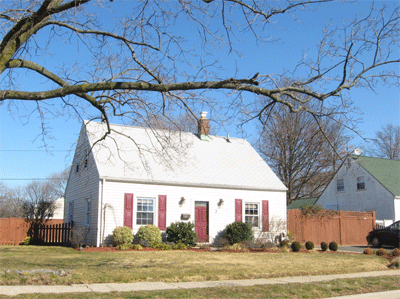An article in The Wall Street Journal details the difficulties that were faced by home owners caught in the Goldman Sachs/John Paulson finance scheme ("The Busted Homes Behind a Big Bet"). The article calls the situation a "dizzyingly complex transaction, involving 90 bonds and a 65-page deal sheet. But it all boiled down to whether people ... could pay their mortgages." There is plenty of blame to go around, but surely there were both big winners and big losers is these deals. The big winners were Goldman Sachs and John Paulson. The big losers were the homeowners, though they were not without blame, since they were not forced to take out the excessively large mortgages.
The striking thing about this story, however, is the photograph of a Levittown style house in Aberdeen township, New Jersey, a distant suburb nearly 40 miles from New York City. The picture in the article cannot be directly linked, and the best view is on an interactive slide show linked to the article. We have provided a photograph of a near somewhat smaller house in Levittown (see photo).
 In 2006, the owner had refinanced the house with a $308,750 loan, indicating a value more than triple that of comparable housing in much of metropolitan America.
In 2006, the owner had refinanced the house with a $308,750 loan, indicating a value more than triple that of comparable housing in much of metropolitan America.
Levittown, of course, was the late 1940s housing development on Long Island that set the stage for the automobile oriented suburban expansion that did so much to create the largest and most affluent middle class in the world. The Levittown houses were very small, starting at about 750 square feet, though many have been expanded. It was not long before suburban housing became larger, eventually rising to the present 2,250 square foot median. The Wall Street Journal's Aberdeen township house is under 1,500 square feet, according to Zillow and was built in 1953.
The Wall Street Journal article misses a significant point. How could such a modest (and doubtless comfortable) house have become so valuable that it could justify refinancing for more than $300,000? The answer is simple. During the real estate bubble, house prices in New Jersey exploded. The state's restrictive land use regulation largely prohibit new housing on the suburban fringe, leaving prices nowhere to go but up and up strongly. Between 2000 and 2006, the median house value in Monmouth County, where Aberdeen Township is located, rose 125% (according to US Bureau of the Census data). 2006 data for Aberdeen township is not readily available.
By the peak of the bubble, the median value house in Monmouth County was 5.8 times the median household income, up from 3.0 times in 2000. In 2000, prices were even lower in Aberdeen township, at 2.3 times incomes – well within the 3.0 standard that defined housing affordability for at least one-half century.
While owners were borrowing $300,000 or more on their modest early 1950s houses in Aberdeen township, households were buying brand new houses of the same size for under $120,000 in Dallas-Fort Worth, Atlanta, Houston, Indianapolis and a host of other metropolitan areas where the American Dream had not been outlawed. Expansion of the housing supply was allowed, and prices stayed within historic norms. For example, in Indianapolis, house prices were less than one-half that of Monmouth County, after adjusting for income levels.
Meanwhile, a judgment of $370,000 has been entered against the owner of the Aberdeen township Levittowner. The auction in late April by the Monmouth County Sheriff for a price that is probably closer to its real value if it had been in a rationally regulated jurisdiction: $100.













quitar dolor de cabeza
I agree with the author that the training materials, curricula, online courses, and other courseware created by grantees should be made freely available for reuse to the public. This should be the system and not the other way around where there is still a need to pay for these products.
quitar dolor de cabeza
in the real world
A modest house like that shouldn't cost $370,000 no matter where its located. Its a sixty year oldish house that is basically four rooms and a bath. How can anyone afford that on a normal income? Round here in Indiana some neighborhoods a house like that goes for $80,000. In other places in the US it would be far less than that. If the free market was allowed to work, affordable houses wouldn't be a problem. And we wouldn't have this mortgage mess.
$300,000 is "cheap" where I live.
If you think that's ridiculous, homes smaller than this one where I live ( East Bay, San Francisco) cost $450,000-$500,000, and that's AFTER the bubble pop. During the bubble they were going for $650k. Yes- the jobs pay pretty well here and the weather is ( except for this year) usually perfect. But the prices are ridiculous. We rent for 1/3rd the cost of buying. The Bay Area also has incredibly strict land use regulations. NOTHING new is ever built.